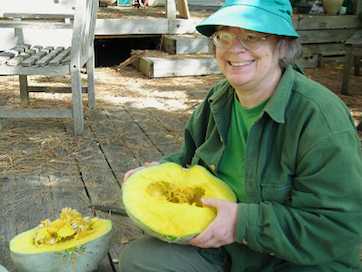
How much land do you need to survive? This is not a theoretical question if, like Carol Deppe, you bellieve the zombie apocalypse is just around the corner.
The author of The Resilient Gardener: Food Production and Self-Reliance in Uncertain Times,Deppe says you need an acre. But others say a quarter acre is enough.
Deppe’s book might help you build a veggie-garden with climate change in mind, but she lives in temperate Corvalis, Oregon, population 54,462. In other parts of the country such as New Mexico, Texas or Nevada, she might have other concerns. As it is, the book is mainly about surviving when the world infrastructure collapses and she has nothing to rely on but herself.
Which brings us back to the vital question of how much land you need to feed yourself and a family. Too much land is just more to defend against the marauding hordes. Too little and you will starve as there will not be enough space for the chickens.
Deppe recommends growing what she considers to be staples in order to survive. These staples are potatoes, corn (not sweet corn but corn for flour and polenta), beans, squash and eggs. If you don’t have a yard at all or a yard big enough to produce enough of these things to live on, then she says you can just lease some farmland.
Presumably you should also live on the farmland, assuming the zoning committee of the local government has ceased to function,otherwise, how will she be able to get to her field to harvest the food? There will be no cars.
How could you haul home a 100 pounds of potatoes, a bushel or two of corn, a bushel or more of beans and 50 pounds of pumpkins in a bicycle basket?
That said, there are useful tips in here: like growing beans with corn and the spacing. Corn should be about four inches tall before you plant the runner beans that will be climbing up the corn stalks.
And you can dry summer squash and use it in winter in soups and stews. Deppe uses a drying frame outdoors for her survivalist harvesting.
It may be better to go for a more practical guide to food-growing, such as: Sepp Holzer’s Permaculture: A Practical Guide to Small-Scale, Integrative Farming and Gardening–With information on mushroom cultivation, sowing a … ways to keep livestock, and more…
this is not a step by step guide, but it does get you right in the spirit of how to do permaculture for yourself, and is best read in conjunction with Sepp Holzer’s youtube videos, A lot of information discussed in those is not covered in this book. For instance, Sepp installs fruit trees between the raised beds, and then uses a mix 50 ancient/heirloom seeds that he just tosses in the raised beds by hand when they are first build (no mention if he lets annuals and biennials reseed themselves or whether he does this every year ). Yes, he doesn’t pre-start them early even at 1500 meters above sea level! Impressive! He says it is “alle wichtisgte” most important to have mixture of vegetables and herbs growing around his fruit trees. Just about everything he recommends is anti-conventional and not what one learns in schools, or from other “experienced” farmers or other gardening books.
<script type=”text/javascript” src=”https://wms.assoc-amazon.com/20070822/US/js/link-enhancer-common.js?tag=offgridnet-20″>
</script>
<noscript>
<img src=”https://wms.assoc-amazon.com/20070822/US/img/noscript.gif?tag=offgridnet-20″ alt=”” />
</noscript>
One Response
good